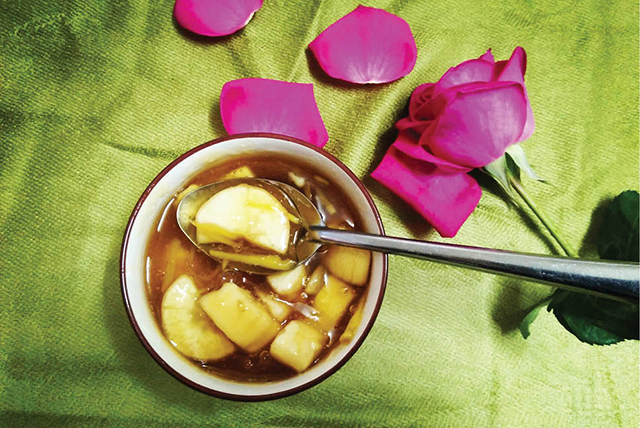
Sweet che san
My youngest ant visited her Mom at weekends, bringing her a box of hot che san. “Did you make it?” asked my grandma with surprise. “I bought it, Mom,” answered honestly my ant.
Grandma struck the divan bed with her hand out of excitement and asked me to run fetching a bowl and pour che san in for her to try. “Oh, my! Can this be bought in the city now? I almost forgot its flavor because I haven’t eaten it for such a long time.”
My aunt was so happy to see her excitement. Grandma said che san now was so different with tender coconut, coconut cream and tapioca. But cassava was still sticky and fragrant of ginger as before.
I remember in the old days, occasionally my grandma cooked che san. It was not because we liked cassava, which we ate so frequently, but just because we missed che (sweet soup). Beans were scarce at the time. Even if she had beans, she often had to sell them for rice.
Winter was freezing; fields were flooded. Che san was the only dish she could make when we wanted something sweet. Then we grew addicted to it. Every time my grandma had cup sugar, she cooked che san.
The main ingredient was certainly cassava, which was easy to find at the time. There were always some three-month cassava roots in her shanty kitchen. She stored them to cook with rice.
Cassava roots were peeled and soaked in water for some time to eliminate the bitterness. She boiled cassava with some pandan which she grew in the garden. Cassava was then so fragrant of pandan.
The sugar used to make che san was usually cup sugar which was manually made. My grandmother crushed the sugar, then cooked it in water.
After that, she threw in cassava and cooked it on a small fire. She waited until the cassava absorbed sugar, then poured in cassava powder which had been dissolved in a bowl of water. Just a small piece of ginger cut into lines was enough for a pot of che san.
You can adjust the amount of sugar and cassava powder to your taste. I like my grandma’s che san because it is not too sweet or too thick. Enjoying che san leisurely in the cold rain by the fire is best.
Che san must be eaten hot. Cassava is so sticky and fragrant of ginger. Sometimes she sprinkled in some half-beaten roasted peanuts, which gave che san nutty flavor.
Later in winter, grandma did not have to sell beans to buy rice any more like the previous days, but she still went to the kitchen to cook a pot of che san when she felt missing it. Then she was older and older. Her che san disappeared from the little kitchen.
This afternoon, carrying the bowl of che san in hand, she said she preferred the flavor of che san in the old days. It was the color of honey; cassava was sweet and fragrant of ginger; and more importantly, it was not dominated by the fatty taste of coconut cream. Cassava without additional tapioca was soft and smooth in mouth.
Poor my grandma! Tomorrow, if it does not rain, I will go to the market to find some cassava roots and sugar to cook a pot of che san for her.
Story and photo: Linh Chi
